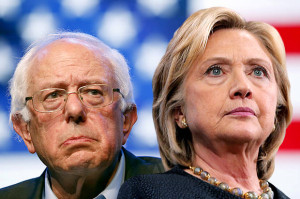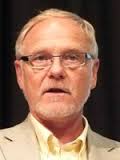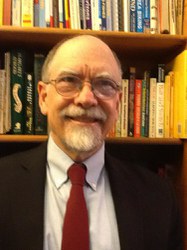
Basak Kus – Sven Steinmo – Josh Pacewicz – Josh McCabe
Monica Prasad – Richard Lachmann- Fred Block- Stephanie Lee Mudge
The question of policy change is at the heart of the contest for the Democratic nomination between Hillary Clinton and Bernie Sanders. What is feasible, what is not? Is major change a possibility? Does the officer matter where the office is subject to such great deal of constraint? We are inviting scholars who study policy change and American politics to weigh in.
 Basak Kus
Basak Kus
Assistant Professor of Sociology
Wesleyan University
On January 22, Paul Krugman wrote an op-ed column in New York Times with the title “How Change Happens.”
This is what he said:
“On the left there is always a contingent of idealistic voters eager to believe that a sufficiently high-minded leader can conjure up the better angels of America’s nature and persuade the broad public to support a radical overhaul of our institutions.”
In 2008, Krugman observes, that contingent rallied behind Mr. Obama.
“But as Mr. Obama himself found out as soon as he took office, transformational rhetoric isn’t how change happens. That’s not to say that he’s a failure. On the contrary, he’s been an extremely consequential president, doing more to advance the progressive agenda than anyone since L.B.J. Yet his achievements have depended at every stage on accepting half loaves as being better than none: health reform that leaves the system largely private, financial reform that seriously restricts Wall Street’s abuses without fully breaking its power, higher taxes on the rich but no full-scale assault on inequality.”
According to Krugman, if Bernie Sanders were to become president, “he would end up facing the same harsh realities that constrained Obama.”
Two days later Former Secretary of Labor Robert Reich responded to Krugman in a blog piece published in truthdig.
“Krugman doesn’t get it. I have been in and around Washington for almost fifty years including a stint in the cabinet, and I’ve learned that real change happens only when a substantial share of the American public is mobilized, organized, energized, and determined to make it happen. Political “pragmatism” may require accepting “half loaves” – but the full loaf has to be large and bold enough in the first place to make the half loaf meaningful. That’s why the movement must aim high – toward a single-payer universal health, free public higher education, and busting up the biggest banks, for example. But not even a half loaf is possible unless or until we wrest back power from the executives of large corporations, Wall Street bankers, and billionaires who now control the whole bakery. Which means getting big money out of politics and severing the link between wealth and political power – the central goal of the movement Bernie is advancing.”
With respect to the question of how policy change happens in the US, it is hard to disagree with Krugman. The institutional context of policymaking in the US has certain features that make it difficult to pass bills that are radical and ambitious. To begin with, political authority remains fragmented with a high number of veto points. Second, individual members of the Congress retain a lot of power, as Steinmo notes, making it exceptionally difficult for party leaders to push them into particular policy positions. And third, interest groups maintain a high level of influence over legislative outcomes. As a result, policy change, when it happens, often takes a pragmatic and incrementalist form.
Against this context, I personally find Mr. Obama’s presidency to be quite successful. Others think that it was not the transformational political movement that they expected.
The question of policy change is at the heart of the contest for the Democratic nomination between Hillary Clinton and Bernie Sanders: What is feasible, what is not? Is major change a possibility? Does the officer matter where the office is subject to such great deal of constraint?
We are inviting scholars who study policy change and American politics to weigh in.
 Sven Steinmo
Sven Steinmo
Professor of Public Policy and Political Economy
European University Institute
We should never forget that American political institutions were explicitly designed to block the short-term demands of the electorate. This is a central reasons why Americans — on both left and right — are continually disappointed with their political leaders. Politicians run for office and promise that they will change the status quo. The reality, however, is that once they get elected, they confront a fragmented, disorganized, and increasingly dysfunctional system of “checks and balances” that is specifically designed to prevent the “popular mood” from becoming public policy.
Seen in this context, President Obama’s success with the Affordable Care Act is historic in and of itself. I, and many others, thought that this would be virtually impossible in the United States. At the same time, the inflated expectations set out by Obama’s “idealistic voters” were bound to be dashed. The President, after all, controls neither the U.S. Congress nor the American economy.
Will Bernie Sanders be more likely to “change” America? Certainly not. If Senator Sanders were by some bizarre twist of fate able to get elected as the President of the United States (if, for example, if Donald Trump were his Republican opponent and Michael Bloomberg did not enter the election) President Sanders would face the same institutional obstacles that Obama confronted. He would also face an increasingly angry and obstreperous Republican House of Representatives.
To be fair, a president Hillary Clinton would face the same opposition from the Republican right. But then again, she is not promising the moon.
So pick your poison: a candidate who promises what he cannot deliver, or a candidate who does not promise to deliver much, but will not disappoint.
![pacewiczphoto[1]](http://policytrajectories.asa-comparative-historical.org/wp-content/uploads/2016/02/pacewiczphoto1.jpg) Josh Pacewicz
Josh Pacewicz
Assistant Professor of Sociology
Brown University
Forget new policies. Pick a president who will keep and creatively implement the ones we’ve got.
The conventional wisdom appears to be that Democratic majorities in the house or senate are unlikely in the years to come, which probably means that ambitious new social programs are also off the table. So to an extent, I agree with Krugman over Reich about the likelihood of progressive legislation, but also think that both are wrong to equate progressive reforms solely with new legislation. The presidency is an executive position with greatest influence over the implementation of existing laws. Proponents of the welfare state should therefore look to a Democratic presidential candidate who will creatively implement the social programs we’ve already got (in addition, of course, to blocking Republican roll-back and reform efforts). To those hoping for a political revolution, policy implementation may sound like incrementalism—and partially it is—but it also creates meaningful opportunity for welfare state expansion.
Consider a brief example with which I’m just now becoming familiar via a new fieldwork project: implementation of the Affordable Care Act (ACA), particularly as it pertains to providing health care and services to low-income populations. Arguably, the biggest impact of the ACA has been expansion of Medicaid coverage to low income populations, which some critics contend—correctly, I think—simply aids people in dire poverty without doing much for those just above the income cutoff. I’m most familiar with the situation in Rhode Island, which operates one of America’s most effective health exchanges, and even here the premiums for policies available on the exchange are unaffordable for many families, even for so-so health plans after extensive tax write-offs and state subsidies. Private sector health insurance will probably always be unaffordable for many people unless heavily subsidized and regulated—that’s the bad news. But the good news is that the ACA is also transforming the state’s social service sector in non-incremental ways.
To unpack the latter process, I need say a few words about how Medicaid works: it is a classic example of delegated governance in the sense that the federal government simply matches states’ Medicaid-eligible spending. This arrangement creates opportunities for Medicaid expansion via creative reimbursement systems and expanding definitions of Medicaid-eligible spending. To expand Medicaid in these ways, state civil servants need only obtain a waiver from the Center for Medicaid and Medicare Services (CMS), a bureaucrat to bureaucrat circuit of communication that is largely insulated from legislative influence. My informants in Rhode Island describe the ACAs impact on this process in revolutionary tones: as a “paradigm shift” at CMS, which has altered how federal bureaucrats evaluate state waivers. For instance, recent waivers in Rhode Island have made various sorts of home upgrades, in-home care giving, substance abuse, mental health, and even financial counseling Medicaid-eligible. Other features of the ACA like the creation of Accountable Care Organizations (ACOs) create even more opportunities for re-classifying social services as federally- subsidized health care spending. And other states have been more ambitious still. New York tried unsuccessfully to obtain a CMS waiver to use
Medicaid dollars to pay for rental subsidies while Vermont operates a state owned Managed Care Organization (MCO) for Medicaid recipients—essentially, a public health insurance company.
To some, such changes may appear less revolutionary than sweeping new legislation, but I doubt that they are any less meaningful to those who are now receiving much needed social services for the first time. My suspicion is that there are analogous opportunities for creative implementation of other social programs. In 2016, you should probably forget about revolutionary legislative change, but do look for a candidate who will perpetuate and extend revolutionary paradigm shifts within other executive agencies.
 Josh McCabe
Josh McCabe
Freedom Project Postdoctoral Fellow
Wellesley College
Slow and Steady Wins the Race.
We often identify major changes with “big bangs” in policy history. For liberals, the models to emulate are the program that came out of the New Deal or the Great Society. As such, they tend to lionize presidential figures such as FDR and LBJ. Not only does political sociology take a much more limited view of what presidents can achieve, it also cautions us against focusing on major changes that occur quickly versus those that only become apparent over time.
Given the array of institutional constraints, a shrewd president looks beyond the immediate effects of potential policy changes and to take feedback effects into account. Small changes can alter the political calculus for stakeholders, giving them an interest in program growth or retrenchment that only manifests itself slowly over time. Wolfgang Streek and Kathleen Thelen outline several mechanisms through which incremental policy modifications can lead to major shifts in policy. Reagan and Obama offer two illustrative examples.
Conservatives typically celebrate Reagan’s decision to cut marginal tax rates in his 1981 budget as a bold strike against rising taxes but these changes only had a moderate effect on tax revenues in the longer run. The real triumph was Reagan’s decision to automatically index tax brackets and rates to inflation. Treasury Secretary Donald Regan supposedly told staffers: “My favorite part of the tax bill is the indexing provision – it takes the sand out of Congress’s sandbox.” Indexation had little immediate effect. By 1990 though, rate cuts had cost the government $80 billion annually while indexation had cost it $180 billion. Subsequent administrations have been able to raise the top tax rate but attempts to eliminate indexation would certainly be met with public outrage.
In Obama’s case, many liberals consider the Affordable Care Act to be a political success because he made all the necessary compromises in order to get it passed. This misses the larger point. As it currently stands, the ACA achieves very few of its goals. Obama’s brilliance lay in the foresight to pass an ugly law now that will grow just as Republicans fear and eventually turn into a single payer system as states slowly buy into the free lunch offered by the Medicaid expansion. It’s a dirty little secret that he can’t admit publicly. It’s also a brilliant strategy. Attempts to roll back Medicaid expansions would be political suicide.
What does this have to do with the choice between Sanders and Clinton? Reagan talked tough. Obama talked compromise. But talk is cheap. Both still achieved major policy changes by strategically playing the long game. I’m not sure the debate is between being tough (Sanders) or willing to compromise (Clinton) so much as it is about which presidential candidate has the foresight to think about how the choices they make today will lay the foundations for major change to unfold long after they’re gone.
 Monica Prasad
Monica Prasad
Professor of Sociology
Northwestern University
The one thing Clinton, Sanders, and even the Republican candidates agree on is that there’s too much money in politics.
But money doesn’t matter as much as everyone thinks. The most comprehensive recent study of the effect of money on politics is Martin Gilens’s Affluence and Influence. It gets mentioned often in debates these days as showing that the political system is more responsive to the affluent than to the poor. But Gilens is not actually saying what people who haven’t read the book think he’s saying.
Gilens compiled a detailed dataset of changes in policy outcomes and policy preferences of the affluent, the middle classes, and the poor over several decades. His finding? The president most responsive to the preferences of the poor was George W. Bush (p.202).
This is because many of the areas where the affluent and the poor disagree are social issues, and on social issues what it means to be more responsive to the affluent than the poor is to favor stem cell research, gay marriage, and the right to abortion; moreover, the poor are more likely to favor restrictions on free speech, school prayer, and mandatory AIDS testing (p.78, p.109). Republicans have often been more in line with the preferences of the poor in many of these areas. In fact “representational inequality is greater and responsiveness to all income levels (including the poor) lower under Democratic control” (p.8).
But is this really an indication of the effect of money? Do Democratic politicians support reproductive choice because they have sold themselves out to Big Abortion? Or is it because their constituencies are pro-choice, and/or they are themselves pro-choice? You tell me.
On economic issues there are some issues on which Gilens does think the affluent get their way, such as on cuts in top tax rates, but on other issues the poor do, such as the refusal to move Medicare and Social Security in a more market oriented direction, which is “consistent with the strong support for these highly salient programs among low- and middle-income Americans” (p.120). Overall, it’s hard to read Gilens’s book carefully and come away with a picture of the wealthy controlling American democracy, despite Gilens’s own protestations to that effect.
So if money is not as important as everyone thinks (and email me if you want to see my critiques of other recent research that gets invoked in this debate), what is it that’s preventing the United States from developing the kind of welfare state seen in other industrial countries? As Sanders keeps noting, we are the only advanced industrial country without universal health care. If not money, what could it be producing that outcome?
The answer is….that I do have an answer, but it’s far too complicated to put into one blog post. I’ll be writing a series of blog posts later in the spring on this (and meanwhile, read my books The Politics of Free Markets and The Land of Too Much if you want the full story!).
Professor of Sociology
SUNY- Albany
Of course the American political system, even more than those in most countries, is structured in ways that make it very difficult for non-elites to influence policy in significant ways. Basak Kus identifies some of the key ones: multiple veto points, the breakdown of party discipline that empowers individual members of Congress, and the power of interest groups. To that we can add elites’ vastly disproportionate role in financing campaigns, especially below the presidential level, and capitalists’ ability to hoard capital (i.e. engage in capital strikes) or invest it abroad unless and until government officials adopt the policies capitalists want.
However, if we look at moments when elites have not gotten their way, on matters big and small, we find that progressive/leftist/anti-capitalist policies were instituted following massive non-elite mobilization: by workers and farmers in the 1930s and students and African-Americans in the 1960s. Such mobilization has become extremely rare in the US in recent decades as unions have atrophied, other progressive organizations have proven almost entirely incapable of mobilizing voters or demonstrators, and most campaign contributions come from the very wealthy and from corporations that carefully track Congressional votes on the legislation that directly affects their interests.
In such an environment, reforms can only be bought with Federal funds that guarantee special interests are held virtually harmless. That was how Obama got his landmark health care legislation through Congress. Such a legislative feat is unlikely to be repeated because the money for such deals is disappearing as the long recession and tax cut mania continue to ensure massive deficits as far as can be projected. In any case, Obama could get his plan passed only because the Democrats won supermajorities in Congress following Bush’s disastrous Iraq war and the 2008 financial collapse.
Neither Clinton nor Sanders would face such auspicious conditions if they were elected president. Either could use a president’s vast regulatory power to further institutionalize Obama’s reforms and they could better enforce the vague but broad provisions in Dodd-Frank and other laws that give the executive broad regulatory powers, as Pacewicz and McCabe point out. However, the main way a progressive president can build political capital is to encourage mass mobilization. Obama failed to do that; he consciously demobilized the supporters who had been identified and activated by his 2008 campaign. Clinton doesn’t inspire such enthusiasm in the first place and her idea of the presidency, which she has expressed in similar terms in both her 2008 and 2016 campaigns, focuses on insider maneuvers that have no place for non-elite participation. Sanders in contrast would attain the presidency only if he can evoke and inspire a level of popular participation we have not seen in a half-century. He would be aware of the necessity of trying to sustain mass mobilization if he wants to achieve any of his goals even in part. Sanders’ election and presidency would create the conditions that could spark a new era of mass democracy.
Research Professor
U.C. Davis
The odds are definitely against it, but a transformation on the scale of Franklin Roosevelt’s New Deal remains a possibility if the Democrats successfully hold on to the presidency in 2016. Yes, U.S. politics is characterized by multiple veto points that make periods of transformational change a rarity. Nevertheless, major periods of reform do tend to occur at thirty or forty year intervals. And we are also long overdue for such a rupture; the last major reform period occurred between 1964 and 1970 and it included the Civil Rights Act, the Voting Rights Act, immigration reform, Medicare and Medicaid, and the creation of the Environmental Protection Agency and the Occupational Health and Safety Agency. But all of that happened almost a half century ago.
That major reforms are long overdue has become glaringly obvious in many different corners of the society. Our infrastructure of roads, bridges, and airports, our water and sewer systems, our electrical grid, our internet are either crumbling or increasingly obsolete. Our tax system is unable to provide sufficient revenue to meet basic needs. Everyone agrees that our immigration system is severely dysfunctional. Our educational system is failing to provide the skills that the labor force needs or avenues for upward mobility as college students contend with massive debt burdens. Most critically, the economy is no longer producing enough jobs with decent pay and employment security.
We can also see some of the key indicators that typically occur in the period preceding a reform epoch. There is broad public disappointment with both major parties as exemplified by the anti-establishment campaigns of Donald Trump and Bernie Sanders. While Trump and Sanders have sharply divergent views, they both are decrying the corruption of our political system and the failure of our economy to deliver the goods to most of the population.
Second, we are also witnessing division and disarray within the economic elites that usually dominate our politics. This is important because political sociologists have frequently emphasized that insurgencies grow when people see opportunities created by a divided elite. The Republican Party is increasingly dominated by a far right faction of the business class led by the Koch Brothers that is intent on rolling back both the New Deal and most of the reforms made in the Progressive Era. Their policies are increasingly alarming to more pragmatic business people who rely on a wide variety of public programs and actually favor responding to the threat of climate change. At the same time, significant elements of the business community have grown more closely allied to the Democratic Party.
Divisions within the economic elite are critical because they make it harder to repress social movements when they begin engaging in widespread protest activity. As Richard Lachmann emphasizes such grassroots mobilizations have been an indispensable element of earlier reform periods. This is the truth in Bernie Sanders repeated argument that only a “political revolution” will bring about the major reforms that he advocates. Such a political revolution requires not just mobilizing millions of people who previously did not vote to go to the polls; it also depends on those people remaining mobilized after the election and repeatedly engaging in mass protests to force governmental action.
But a second critical element of earlier reform periods is a president, drawn from the political establishment, who is able to persuade centrist colleagues that the only way to avoid more chaos and disorder is to pass reform measures that had previously had little chance of enactment. This is the role that Roosevelt played in the 1930’s and Lyndon Johnson in the 1960’s. It as an indispensable role because such establishment figures know how to wield the levers of politics and they know the kinds of rhetorical appeals that can move incumbent politicians to stop obstructing change.
In fact, the record in the U.S. of outsider figures elected to be president is not encouraging. Perhaps, the most recent example was Jimmy Carter who had few links to Washington when he was elected in 1976. On domestic policy, Carter’s record was one of uninterrupted failure despite the fact that Democrats controlled both houses of Congress. To be sure, Sanders has been in the U.S. Congress for decades, but that is hardly the same thing as knowing how to get legislation passed.
Ironically, the ideal combination for a reform epoch would be for an experienced political outsider to rally a massive protest movement while an establishment President cajoled her colleagues into legislating desperately needed reforms. The participants in the Democratic primary might well be auditioning for those very roles.
Assistant Professor of Sociology
U.C. Davis
With all due respect, my main reaction to the question of whether transformational policy change from the left is possible, given institutional constraints on the office of the president, is that right now I think it’s not the main concern. I’d be more concerned with the practicalities of policies if I thought that was where the action was. But it seems to me that policy is where the action is not. The action is in politics.
Let me be clear: I do not mean that policy possibilities are unimportant (they are). What I mean is that policy possibilities—proposals to make or unmake a rule, to be introduced into a given legislative arena—are not driving representative politics in the current moment. The more important driver, I think, is a split between voters looking for competence, and voters looking for charisma (in the Weberian sense).
In the opposition between supporters of Sanders versus Clinton, or indeed Trump versus, … um, everyone else, one can see that there are a lot of voters out there who are mainly swayed by charisma or competence, but not both. I know I know, the distinction between competence and charisma is always in play during elections. But in an ideal world you’d have voters who want a mix. What strikes me at present is that there are so many voters out there who see one or the other as undesirable. This is not a good state for democratic politics to be in, and it worries me a lot more right now than the feasibility of any of the candidates’ policy proposals.
I’m not usually a fan of economic voter theories, but I do think they have their time and place. Now is one of them. In an age of grotesque inequality in wealth and income—documented in so many studies that I hardly know what to pick for my undergraduate classes—it seems reasonable to guess that the divorce of competence and charisma expresses a politics of anxiety an age in which few feel safe from economic risk (or, perhaps, just risk in general). Among the many things that feel special about the present moment is how deeply into the American socioeconomic landscape a sense of exposure, rooted in a now decades-long experience of actual exposure, now intrudes.
Voters who are afraid worry less about pragmatism and practicality, and more about strength and conviction. Voters who feel like politicians haven’t been paying attention start to like the candidate who shouts clearest and loudest. If Bernie started proposing policies that folks like Paul Krugman found plausible, he wouldn’t be Bernie. And he wouldn’t be the candidate his supporters seek.
Anyway, if Reich is right and there is some sort of lefty uprising on the American horizon, then Sanders is right about his “political revolution”: after the next election, we get a Democratic Congress, Democratic White House, and an (unofficially) Democratic Supreme Court. But we should keep in mind that Sanders isn’t the only one who’s proposing policies that some people find unrealistic and extreme, and that progressive revolution isn’t the only variety of revolution that history has on offer. So, no matter who makes it to the White House, I hope that the checks and balances and veto points of American political institutions hold up, and do the job they were designed to do: prevent autocratic decision-making.



